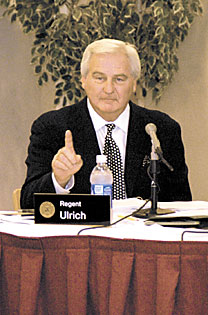 |
|
KELLEY KARNES/State Press (Arizona State University)
|
Regent Donald Ulrich addresses concerns about any fees that will be passed on to students in the Nursing program yesterday at the ABOR meeting held in the ASU Memorial Union.
|
|
|
By Tim Lake
Arizona Daily Wildcat
Friday September 26, 2003
TEMPE - The Arizona Board of Regents unanimously approved a five-year plan yesterday to double the number of nursing graduates in the state.
The regents discussed the $40.3 million plan at their meeting, which was held at ASU.
Of that, $21.5 million will go to the nursing program at the UA.
The source of this funding is still uncertain but could come from the general fund, accelerated nursing program fees, and new and continued partnerships with hospitals, according to a summary of the plan presented to regents.
The accelerated nursing program is a 14-month program designed for those who wish to go into nursing and already have a bachelor's degree.
"It's the most comprehensive work development program in the state," said Regent Don Ulrich.
New fees for nursing students in the accelerated program would be paid for by the healthcare industry, said Ulrich.
When Regent Gary Stuart asked if this would solve the nursing shortage in Arizona, the panel presenting the plan said it would take nearly three times the number of current nursing graduates for the state to reach the already low national average.
In addition to the five-year plan, the regents discussed policies concerning off-campus learning.
Last year, regents changed a policy that limited geographic boundaries for distance learning programs as part of the Changing Directions initiative.
This year the universities are asking the regents to change additional policies related to distance learning, including one that does not allow universities to offer courses off campus that aren't taught on campus.
Many of the universities' distance learning courses are tailor-made for off-campus students, said NAU President John Haeger.
Haeger also said that there needs to be policies that address Web-based distance learning courses.
All of the current policies were developed before the Web, he said.
Haeger said there are a lot of opportunities for higher education to use technology.
Technology is only "nipping around the edges of higher education," he said.
NAU has many courses available online, and there are some 30 degrees available through online instruction, Haeger said.
UA students are already taking some of these online courses, Haeger said.
Haeger said the future of higher education may look very different and even said there may be "no reason to have semesters."
During a forum where the audience could speak and ask questions, graduate student representatives said they want a 100 percent tuition remission for graduate student employees.
"Graduate students carry a lot of the workload," said Jennifer Jacovitch, an English graduate student and teaching assistant.
The board was also updated on the outcomes of grants given to faculty to try new methods of teaching.
The program, called Learner Centered Education, breaks away from the standard class format of lectures, mid-terms and final exams.
Participants praised the program, but Ulrich said he wanted to know how to prove the actual success rates of the program.
UA President Peter Likins defended the grant program.
"Please keep in mind, one of our goals is to make lifelong learners out of our students. We can measure that in 20 to 30 years," he said.

